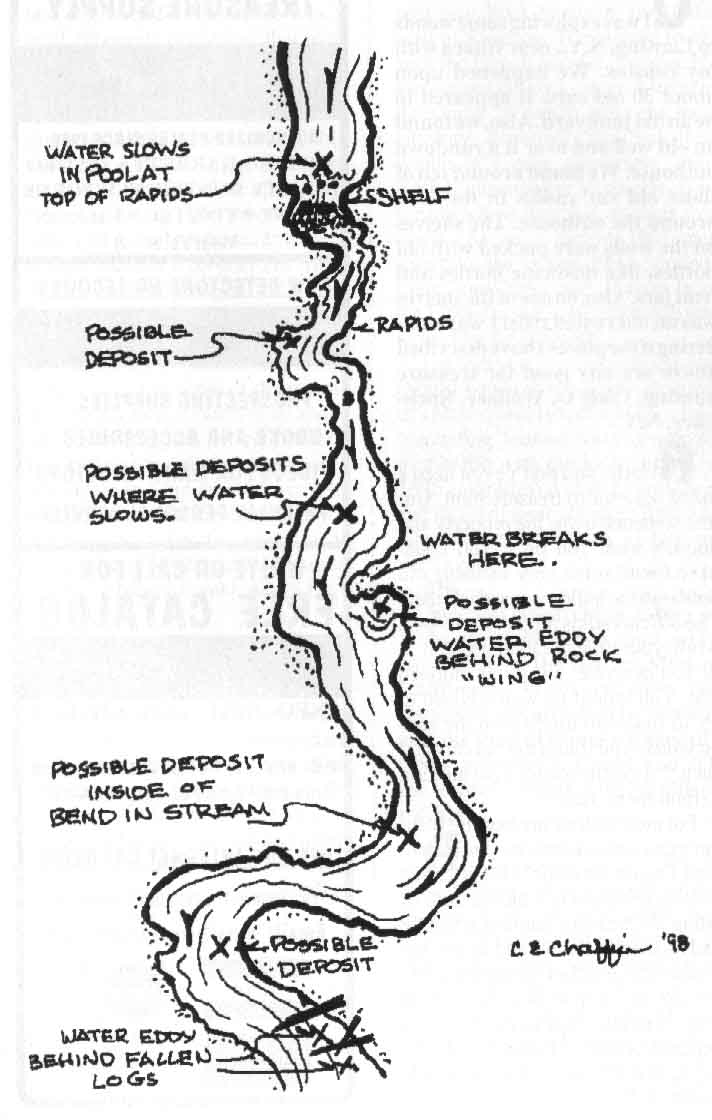As far as gold deposit diagrams go that is probably the better one.
I wouldn't treat these diagrams it as the bible of how to find gold though.
Through experience it does get easier to find the gold. the thing is the gold doesn't do what is often expected in these diagrams. there are just so many variables. Such diagrams aren't so bad for bigger type rivers but for a small confined stream in bedrock, such as most tributaries, the gold can deposit in many more places.
i spent a ton of time fully working the same stretch of stream. while the gold return may be better somewhere else i found it very educational seeing where the gold was. i have also reworked some bits after floods to see where it redeposits.
some examples i have found in this case:
1. even the biggest dirtiest flood moves stuff all gold. the gold only moves when it is forced to. i.e. the big boulder it is stuck by is sluiced off bedrock with everything else following. i have found the boulders etc along with sediments, bind together extremely well. once you have dug around a lot this binding ability is lost, thus allowing materials to easily be washed off the bedrock. if there is no bedrock this will not happen of course. i have found very fine gold in the flood sediments that were fresh. and the odd bigger flat flake, as these are the ones that tend to flip and slide more easily. the chunky stuff really doesn't want to move.
2. if you put on a mask and snorkel rather than just blind dig you can see more distinctly the gold deposits. i have found here that the gold can be on the bedrock, of course. anywhere is can get stuck, any holes, cracks etc, esp on or near a ridge, however big or small, of bedrock. this teneded to be the case where the gold could get to the bedrock. often the sediments are so packed the gold can't get through them as easily, thus gold is on the sediments. this is often bigger bits too.
3. the big boulders. always look here first. these may be the biggest trap. the book will tell you to look on the downstream side. i would always look on the upstream side also. gold often gets stuck here too, often in the thinnest film of mud that could adhere the gold to the boulder, or in the cobbles that have piled up against the boulder.
4. bedrock ridges are a great indicator. the rougher the better. if theres gold here chances are if you follow the ridge down the golden trail will continue.
this also applies the other way round. if you follow it up the bank it may well continue also if no one has cleaned it out.
5. nearly every ridge and crevice should catch gold. thing is often this is unfortunately not the case. these golden rules often fail. about here it pays to think how well worked over the spot has been by others. perhaps now would be the time to try the hardest to reach spot (i.e. deepest crevice, under the biggest boulder etc). if there is nothing here is could be time to move on!
6. often people in a new spot, esp in the well used locations, give up too soon. they are simply digging tailings. think about each time a sluiceboxer goes out. they build a little wing dam up for the box and all. well, these arrangements of rock tend to stand up well to floods. you may well find successive wing dams have raised the streambed tailings considerably. thus any digging is a waste of time. you may need to dig a metre just to get to what had been the previous surface level not long ago. often a sign of this can be fresh leaves sticks and branches in the sediments. that said i have seen wood that has been in the water since at least the 1930s. the miners used what i think was manuka as sticks a couple of feet long and several inches wide to help the stacked rock walls stick to the bedrock i believe. under the first row of rock that would have otherwise been in contact with the bedrock.
7. look for hard pack. you are more likely to get the gold in or on that than flying around on the surface or near surface.
8. there are all these rules but look everywhere. you never know. you might find something somewhere no one has thought worth looking.
9. talk to others and share you experiences. look at how its done, or shouldn't be done, on the various youtube clips.
10. the more you get out the more you should learn. that said try lots of differing locations rather than the same old river and the same old spot. try a different form of fossicking. if you always sluice try detecting. see where these other forms of prospecting are finding gold.
11. learn about geology, fault lines, and glaciers. the more you learn the less time you will end up wasting when you get time to head out.
lastly and slightly off topic, make your own tools. saves your hard earned money. it doesn't matter as much watching your gear float off/get buried if you can easily replace it and haven't spent a fortune on it. i've seen so much gear bought. often the flasher it is the less it gets used. even the pro stuff often need modified or doesn't suit. often the most simple things can replace a pricey purchase.
hopes something here helps someone out there.










